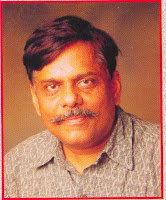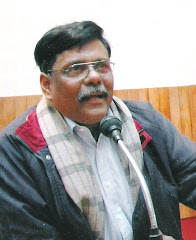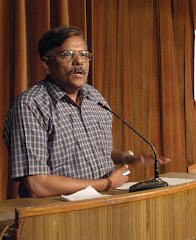In a an interview with Teesta Setalvad, Vibhuti Narain Rai, IG, BSF spoke about the ISI threat to India, its implications on the country and the minority communities.
His main contention was that if the Indian state and Indian law enforcement authorities refuse to distinguish between the ISI and Indian Muslims, we are playing into the hands of the ISI. Excerpts:
Q: Pakistan’s Inter-State Intelligence agency is increasingly being mentioned as the hand behind most extremist acts in the country. What are the facts about the ISI’s involvement in them? How much of it is xenophobic fiction?
A: The ISI is a frightening reality today. I personally feel that as an institution, it is the biggest challenge and threat which the Indian state is facing today. We must face this challenge unitedly as a nation.
Q: Today, for any petty incident, a Hindu girl marrying a Muslim boy or some such, sections of the media and Hindu extremist groups label it as the handiwork of the ISI! In the circumstances, is not an official white paper on the ISI essential to provide convincing proof of its network and activities in India?
A: I think we should publish a white paper that details the scope and reach of the ISI and the threat that it represents. This will put all the facts before the people on the far-reaching activities of the ISI network. Such a document will also prevent the attempt by some to use the ISI as a bogey, as one more stick to bash some of our own people with!
Q: Doesn’t the government’s refusal to place such a document before Parliament and the people help fuel more rumours and phobia about the ISI and which in turn is given communal-sectarian connotations by extremist organisations like the Vishwa Hindu Parishad, Bajrang Dal and the Shiv Sena?
A: I repeat that such a white paper in the nature of a public document should be released. And we must have the strength and capabilities of realising our own mistakes internally. This document must contain details of the intelligence collected, dangers to be guarded against. It must take our people, especially the intelligentsia, into confidence. We should not provide breeding grounds to the ISI. If our minorities lose faith in the Indian State, due to acts of commissions and omissions of the police or other agencies they will be easy prey for the ISI.
Q: Could you elaborate?
A: What were the bomb blasts in Mumbai after all? We presented a golden opportunity to the ISI to utilise the despair and disenchantment caused by the viciously motivated violence against the minorities in December 1992 and January 1993.
Q: Given the sensitive nature of the situation, how must a force like the ISI be tackled?
A: A threat like the one posed to India by the ISI has to be tackled on two fronts: one, as a law and order issue, internally; and, two, on the international front. On the first front, the implementation of the law must be firm and neutral. In fact, the neutrality of the police force, paramilitary and other wings of the law and order machinery are absolute prerequisites if the ISI threat is to be tackled effectively.
There is no other country in the world that can boast of a minority that is 120-million strong. Yet, it is this community whose “nationalistic credentials” are constantly “suspect” because of the religious-communal dimension of the ISI-driven propaganda.
The second front on which the ISI must be dealt with involves ultra-professionalism and political expertise because here we are dealing with international crime that is geared to exploiting our weaknesses from within. On the one hand is the harsh reality of the ISI backed by the two nation theory, vital to the survival of the Pakistan state and on the other, are Hindu fascist organisations whose basic philosophy, too, militates against the idea of different religious communities and peoples of many identities living together, co-existing.
Their approach, too, supports Pakistan’s two-nation theory. I personally would not at all be surprised if a criminal like Dara Singh, who is espousing hatred against Indian Christians, is found to be an ISI agent! If we, as the Indian State, as the law enforcement authorities, or as Indian civil society, refuse to distinguish between the ISI and Indian Muslims and constantly blur this crucial distinction, we are playing into the hands of the ISI. We are supporting the genesis of the two-nation theory, which is exactly what the ISI wants.
Any organisation, whether Hindu or Muslim, which propagates hatred and believes that Hindus and Muslims represent two different civilisations and have no commonalities is playing the ISI game.
Q: Is there any community-specific recruitment by the ISI given the communal undertones of the animosities between the two countries?
A: If you were to examine in detail all the espionage-related arrests made since Independence, we can see that non-Muslims and Muslims — Hindus, Christians and Sikhs — have all been caught for spying. This includes those caught for spying at the army headquarters, defence establishments, our top scientific establishments. Monetary gains and the greed for more are not confined to a particular community! However, when it comes to the burgeoning of madrassas and the kind of teaching that takes place within them, other factors play a role.
It is only when a section of people, an entire religious community in this case, feels wronged and alienated — and can there be any question that that is how India’s religious minorities are feeling at the moment — when their faith in the impartiality of the state machinery is completely eroded, that they become easy prey for the designs of an outfit like the ISI. Apni galtiyon se ham ISI ko palne aur phailne ka mauka de rahen hain.
Q: But madrassas in India have existed for centuries. So, how justified is the assumption of the Indian intelligence agencies that the recent sprouting of madrassas, especially in border districts, like the ones in Pakistan, have the same ideological thrust towards jihad and pan-Islamism?
A: But where will the recruits from such institutions go, for jobs, once they emerge from these madrassas? The madrassas offer no vocational training. Personally I also feel that madrassas are against Muslims themselves. The education and orientation imparted within the madrassa system does not help the community in acquiring a progressive, scientific and modern outlook. Rather, it makes them backward and incapable of facing the challenges of living in contemporary society. You will rarely ever find a well-placed Muslim sending his children to a madrassa.
We have the phenomenon of an increasing number of such madrassas mushrooming in parts of India, especially in the border areas of Nepal and Bengal. The reason why intelligence is looking at these madrassas is that for example, part of the training that takes place at Muridke, Pakistan by the Dawa-ul-Irshad (where recruits of the Lashkar-e-Toeba hail from) in Pakistan is to teach the young Muslim who hails from poor backgrounds is that he is not a real Muslim unless he undertakes this mission of jihad.
Q: But have intelligence agencies specifically studied what is being taught inside madrassas within India?
A: No comprehensive study on the curricular teachings within madrassas has so far been made. But we do have the concrete example of Tripura where state intervention has yielded positive results. In Tripura, the state was contributing to the grants made to madrassas. The state’s DGP suggested a deepening of the madrassa curriculum to include within its scope vocational training like computer application. This has made a marked difference in the opportunities available to the students who emerge out of these institutions in terms of job prospects.
Q: Some organisations seem to be deliberately creating the impression in the public mind that Muslims alone get lured by the ISI. Since this is not true, why can’t the government release a list of those spying for Pakistan to counter such motivated propaganda?
A: Normally when an ISI agent or spy working for Pakistan is arrested, his names and details are published in newspapers. There can be no harm if a consolidated list is published from time to time. I would again like to reiterate the fact that apart from Muslims, large numbers of Hindus, Sikhs and Christians have been arrested over the years for spying for Pakistan. In many cases it is monetary gain which is the motivating factor.
By arrangement with the Mumbai-based monthly, Communalism Combat

























